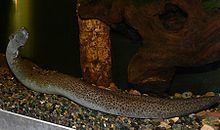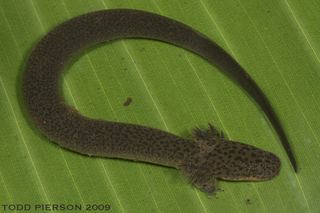Order Urodela Scientific name Sirenidae Rank Family | Phylum Chordata Higher classification Salamander | |
 | ||
Lower classifications Greater siren, Lesser siren, Dwarf siren | ||
Frustrated cat tries to catch siren in fishtank sirenidae amphibian
Sirenidae, the sirens, are a family of aquatic salamanders. Family members have very small fore limbs, and lack hind limbs altogether. In one species, the skeleton in their fore limbs is made of only cartilage. In contrast to most other salamanders, they have external gills bunched together on the neck in both larval and adult states. Sirens are found only in the Southeastern United States and northern Mexico.
Contents
- Frustrated cat tries to catch siren in fishtank sirenidae amphibian
- Siren sirenidae mudpuppy dog fish salamander in fish tank
- Description
- Taxonomy
- References

Although they are primarily carnivorous, they are the only salamanders observed eating plant material.
Siren sirenidae mudpuppy dog fish salamander in fish tank
Description

Sirens are quite distinct from other salamanders, hence they form their own suborder, Sirenoidea. Sometimes, they are even referred to as a completely distinct order (Meantes or Trachystomata). Genetic analysis confirms the sirens are not closely related to any other salamander group. Many of their unique characteristics seem to be partly primitive and partly derivative.

Sirens are generally eel-like in form, with two tiny, but otherwise fully developed, fore limbs. They range from 25–95 cm (9.8–37.4 in) in length. They are neotenic, although the larval gills are small and functionless at first, and only adults have fully developed gills. Because of this, sirens most likely have evolved from a terrestrial ancestor that still had an aquatic larval stage. Like amphiumas, they are able to cross land on rainy nights.
Except for some patches of small teeth on their palates and on the splenial bone on the inner side of their lower jaws, their mouths have lost all dentition and have been replaced with a horny sheath that resembles a beak. Sirens are omnivorous, feeding mainly on worms, small snails, shrimps, and filamentous algae. They are notable among salamanders (and most amphibians, aside from a few frog species) due to their semi-herbivorous habits.
If the conditions of a water source are unsuitable, a larva will shrink its gills to mere stumps, and may not function at all. They are also able to burrow into mud of drying ponds and encase themselves with a cocoon of mucus to survive periods of drought. During such periods, they breathe with their small but functional lungs.
Unlike other salamanders, an interventricular septum is present in the heart. At least two of the species can produce vocalizations. The structure of sirens' reproductive systems suggests they employ external fertilization. This has finally been confirmed in captive breeding experiments, showcasing that males also engage in parental care, building nests for their offspring.
The combined biomass of Siren intermedia species in a Texas pond exceeded the total biomass of the pond's seven species of fish.
Taxonomy
The siren family (Sirenidae) is subdivided into two genera, with two species each:
